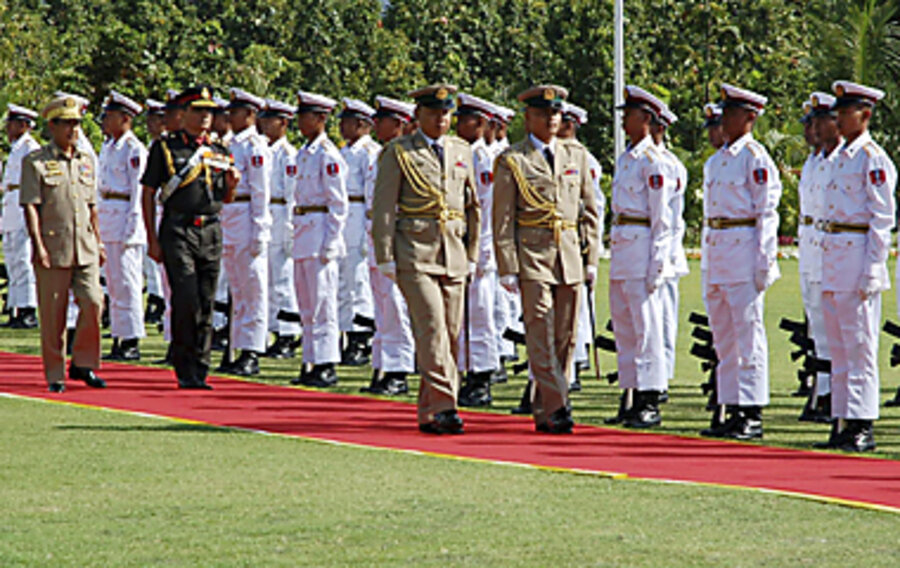Burma's junta in a vise
Loading...
| Bangkok, Thailand
The military junta of Burma (Myanmar) has been busy consolidating control ahead of 2010 elections. Last month it upheld a sentence giving opposition leader Aung San Suu Kyi 18 more months of house arrest, ignoring US calls for her release and its rare offer to engage the pariah regime. But the government still struggles to quell opposition among ethnic insurgency groups – it has cease-fire agreements with 17 of them – in the country's north and east. The best-armed group is probably the United Wa State Army (UWSA), with at least 20,000 combatants and Chinese-made weapons.
The latest flare-up, in the east Burma region of Kokang, in August, sent 30,000 refugees across the border to China, prompting an unusually stern response from that powerful neighbor. Burmese soldiers captured the insurgents' base on Aug. 24.
What is Burma’s goal?
The military would like to neutralize armed threats to its authority before elections next year, its first since 1990. The so-called cease-fire groups – rebels that have signed truces but not laid down arms – are seen as potential spoilers. Ethnic leaders want more autonomy and may block the vote.
Last year, the junta said that all cease-fire groups must convert their armies into border guards under military command. This proposal has been strongly resisted by several groups, including the Myanmar National Democratic Alliance Army, the armed wing in Kokang. By attacking the MNDAA, the junta hopes to scare other groups into complying.
"I don't think the Burmese [military] will give up. They want to get these groups under their control," says Aung Zaw, the editor of Irrawaddy, a Burmese publication in Thailand.
Why does China’s response matter?
China is the closest that Burma has to an ally. It has repeatedly blocked efforts by Western powers to take tougher multilateral action on Burma. China is the regime's main supplier of weapons. Its companies have invested in Burma. Two new pipelines to carry Burmese gas and transshipped crude oil to China are starting construction and would pass through the insurgent-plagued north.
But China's backing of Burma doesn't mean it pulls the strings. Nor is the junta comfortable with growing Chinese influence, according to the International Crisis Group (ICG), a think tank in Brussels.
The violence in Kokang was an irritant to bilateral relations as it spilled over the border and took the lives of ethnic Chinese. In public, China urged Burma to protect the rights of Chinese citizens. In private, Beijing was furious that it had no warning of the attack, says the ICG.
Chinese officials have longstanding ideological ties to former Communist rebels in Burma, including the MNDAA. Cultivating rebel groups along the border is a buffer against Burma's military.
What might Burma do next?
Though no fighting has been reported since Kokang fell, the big fear is that the conflict will spread to areas controlled by the UWSA or the Kachin Independence Army, two rebel groups that strongly oppose the border-guard policy. This could turn a small-scale conflict into a civil war.
Burmese troops continue to fight rebels in the eastern states of Shan and Karen that never signed cease-fires but can only mount guerrilla raids and lack the firepower to hold territory.
A wider conflict has implications for refugee protection, given their flow across the Kokang border into China, says Jim Della-Giacoma, director for Southeast Asia for the ICG, who is based in Jakarta, Indonesia. "The fighting has the potential to spread into other areas controlled by different ethnic groups in Myanmar. If this happened, some predict the impact in terms of refugees would be much greater," he says.
What is the US response, and why is it rethinking its policy on Burma?
The United States hasn't said much on Kokang, though officials recognize that ethnic unrest threatens any transition to greater civilian rule.
In September, the US announced it would start to engage Burma, but keep its sanctions in place. Ms. Suu Kyi said she supported the new policy if opposition groups were included in any dialogue.
After several years of trying to isolate and punish Burma, the US now intends to engage the regime through direct talks, though the Obama administration says it won't lift economic and political sanctions until it sees progress. Human rights activists have argued for tougher sanctions if Burma doesn't change its behavior.
How might this affect elections?
Fighting in border areas would delay the voting there. Wider conflict could lead to a postponement of the elections. Indeed, some analysts think this may be a deliberate military tactic, says editor Aung Zaw.
That said, the regime has stuck to its democracy road map so far, even holding a referendum on a new constitution soon after a devastating cyclone hit in May 2008. No date has been set, and political parties still don't know how and when they can campaign. •





